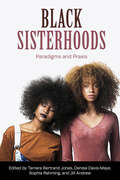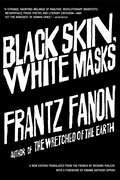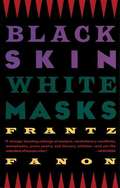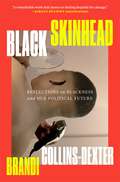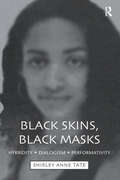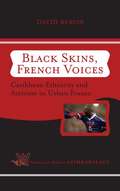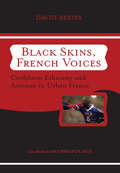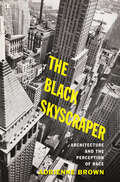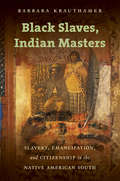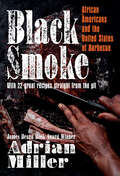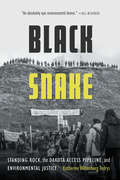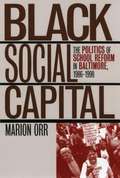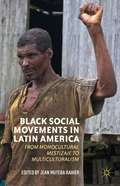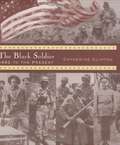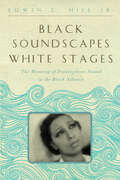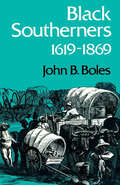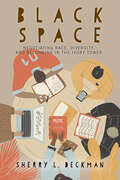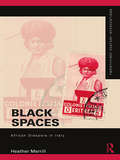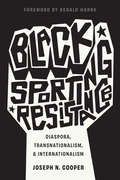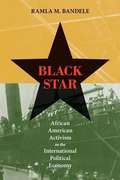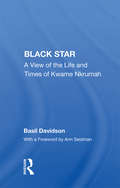- Table View
- List View
Black Sisterhoods: Paradigms and Praxis
by Tamara Bertrand Jones;Denise Davis-Maye;Sophia Rahming;Jill AndrewSisterhood is oft elusive, if not a misunderstood concept. Despite all the factors that could impede the development, elevation, and maintenance of sistering relationships, Black women continue to acknowledge the value of sisterhoods. Sistering offers a lifeline of support and validation. Holding membership in an empowering woman-centered relationship is a special kind of privilege. The authors in this volume contest any assumption that sisterhood is limited to blood relationships and physical proximity. In this volume, we consider sisterhood simultaneously as paradigm and praxis. We approach Sisterhood as Paradigm and attempt to parse out the nature of Sisterhood as it is understood in Black communities in the United States. We hope to convey an organized set of ideas about “sisterhood” to create sisterhood as a model of interaction or way of being with one another, specifically among Black women. As we consider how sisterhood could be enacted as practice. Using Sisterhood as a framework, we explore Sisterhood as Peer Support, examining how Black women provide support to peers in academic and professional settings. we embark on a provision of applied exemplars of sistering in emerging digital media in Digital Sisterhood.
Black Skin, White Masks
by Rachele DiniFrantz Fanon’s explosive Black Skin, White Masks is a merciless exposé of the psychological damage done by colonial rule across the world. Using Fanon’s incisive analytical abilities to expose the consequences of colonialism on the psyches of colonized peoples, it is both a crucial text in post-colonial theory, and a lesson in the power of analytical skills to reveal the realities that hide beneath the surface of things. Fanon was himself part of a colonized nation – Martinique – and grew up with the values and beliefs of French culture imposed upon him, while remaining relegated to an inferior status in society. Qualifying as a psychiatrist in France before working in Algeria (a French colony subject to brutal repression), his own experiences granted him a sharp insight into the psychological problems associated with colonial rule. Like any good analytical thinker, Fanon’s particular skill was in breaking things down and joining dots. His analysis of colonial rule exposed its implicit assumptions – and how they were replicated in colonised populations – allowing Fanon to unpick the hidden reasons behind his own conflicted psychological make up, and those of his patients. Unflinchingly clear-sighted in doing so, Black Skin White Masks remains a shocking read today.
Black Skin, White Masks
by Frantz FanonThe new translation of the classic work by the author of Wretched of the Earth: &“A strange, haunting mélange of analysis [and] revolutionary manifesto&” (Newsweek). Few modern voices have had as profound an impact on the black identity and critical race theory as Frantz Fanon, and Black Skin, White Masks represents some of his most important work. This new translation by Richard Philcox makes Fanon&’s masterwork accessible to a new generation of readers. It also includes a foreword by philosopher Kwame Anthony Appiah. A major influence on civil rights, anti-colonial, and black consciousness movements around the world, Black Skin, White Masks is the unsurpassed study of the black psyche in a white world. Hailed for its scientific analysis and poetic grace when it was first published in 1952, the book remains a vital force today from one of the most important theorists of revolutionary struggle, colonialism, and racial difference in history.
Black Skin, White Masks
by Frantz Fanon Charles Lam MarkmannA distinguished French Caribbean African psychiatrist and writer who was a member originally of the French Negritude group but soon rejected their philosophy and developed his own theory of racial and colonial theory. Franz Fanon, a French Martiniquan writer, published "Black Skin, White Masks" as his first treatise on the effects of Racism and colonialization. Both a memory and a political treatise, "Black Skins, White Masks" is a work illustrating the marginalization and servitude of the Black experience in the Western world. About his experience in Lyon as a member of the French Resistance, this book discusses how language is itself a dominating force against equal racial relations. He argues that language has become a testimony for the power imbalance and reassertment of difference in society. By speaking the language of the colonizers, the colonized continue to allow for their own enslavement through a kind of cultural imprisonment. Fanon greatly influenced the later workings of Michel Foucault and his discussion of hegemonic power in language and culture. Fanon speaks of how the "Antilles Negro" should reject the language and cultural traditions of their aggressor (France) and find their own culture which is separate from that of the colonial bourgeosie. Fanon argues that the colonial bourgeosie's imitation of their French equivalent keeps the Antilles and other Caribbean 'native' culture oppressed through their own lukewarm attempt at emulating French society. According to Fanon, the colonized intellectuals will never empower themselves until they break from the valorization of French language and culture and begin to separate themselves from it.
Black Skinhead: Reflections on Blackness and Our Political Future
by Brandi Collins-Dexter"Political activist Collins-Dexter’s essay collection is timely as well as pointed. In it, she argues that Democrats have taken Black voters for granted, and that the consequences of this mistake have already begun — and will accelerate."—The New York Times,"15 Works of Nonfiction to Read This Fall"For fans of Bad Feminist and The Sum of Us, Black Skinhead sparks a radical conversation about Black America and political identity.In Black Skinhead, Brandi Collins-Dexter, former Senior Campaign Director for Color Of Change, explores the fragile alliance between Black voters and the Democratic party. Through sharp, timely essays that span the political, cultural, and personal, Collins-Dexter reveals decades of simmering disaffection in Black America, told as much through voter statistics as it is through music, film, sports, and the baffling mind of Kanye West.While Black Skinhead is an outward look at Black votership and electoral politics, it is also a funny, deeply personal, and introspective look at Black culture and identity, ultimately revealing a Black America that has become deeply disillusioned with the failed promises of its country.----------------------------------------------------We had been told that everything was fine, that America was working for everyone and that the American Dream was attainable for all. But for those who had been paying attention, there had been warning signs that the Obamas’ version of the American Dream wasn’t working for everyone. That it hadn’t been working for many white Americans was immediately and loudly discussed, but the truth—and what I set out to write this book about—was that it hadn’t been working for many Black Americans either. For many, Obama’s vision had been more illusion than reality all along.When someone tells you everything is fine, but around you, you see evidence that it’s not, where will the quest to find answers lead you? As I went on the journey of writing this book, I found a very different tale about Black politics and Black America, one that countered white America’s long-held assumption that Black voters will always vote Democrat—and even that the Democratic party is the best bet for Black Americans. My ultimate question was this: how are Black people being led away—not towards—each other, and what do we lose when we lose each other? What do we lose when, to quote Kanye West, we feel lost in the world.
Black Skins, Black Masks: Hybridity, Dialogism, Performativity
by Shirley Anne TateBlack Skin, Black Masks: Hybridity, Dialogism, Performativity offers a timely exploration of Black identity and its negotiation. The book draws on empirical work recording everyday conversations between Black women: friends, peers and family members. These conversations are discussed in the light of the work of Homi Bhabha, Stuart Hall, Gerd Baumann, Claire Alexander and others on questions of hybridity, identity, otherness and the development of ’new ethnicities’. Tate aims to address what she sees as significant omissions in contemporary Black Cultural Studies. She argues that theorists have rarely looked at the process of identity construction in terms of lived-experience; and that they have tended to concentrate on the demise of the essential Black subject, paying little attention to gender. The book points to a continuation of a ’politics of the skin’ in Black identities. As such it argues against Bhabha's claim that essence is not central to hybrid identities. The conversations recorded in the book reveal the ways in which women negotiate the category of Blackness, in what Tate calls a 'hybridity-of- the-everyday'. The book introduces a new interpretative vocabulary to look at the ways in which hybridity is orchestrated and fashioned, showing it to be performative, dialogical and dependent on essentialism.
Black Skins, French Voices: Caribbean Ethnicity and Activism in Urban France
by David BerissAbout 337,000 people of French Antillean Origin live in metropolitan France today. Unlike immigrants from North Africa, Turkey or sub-Saharan Africa, Antilleans are French citizens with deep roots in
Black Skins, French Voices: Caribbean Ethnicity And Activism In Urban France (Case Studies in Anthropology)
by David BerissAbout 337,000 people of French Antillean Origin live in metropolitan France today. Unlike immigrants from North Africa, Turkey or sub-Saharan Africa, Antilleans are French citizens with deep roots in French history. Indeed, the Caribbean Islands they come from have been a part of France for over three centuries. Antilleans were for many years an invisible population, dispersed throughout the Paris region, with few community organizations and little political activism.Beginning in the early 1980s, however, activists in the Antillean community began to recognize that their status as citizens would not protect them from the growth of racism in France. From neighborhood groups interested in promoting traditional Martinican and Guadeloupan dance and music to politically charged associations, these new cultural militants denounced French colonialism, challenged racism, and demanded political representation. Black Skins, French Voices is situated at the intersection of changing French ideas and policies regarding ethnic diversity and Antillean demands for recognition. It shows the creative and exciting struggles of Antilleans to remake French culture on their own terms.
Black Skins, French Voices
by David BerissAbout 337,000 people of French Antillean Origin live in metropolitan France today. Unlike immigrants from North Africa, Turkey or sub-Saharan Africa, Antilleans are French citizens with deep roots in French history. Indeed, the Caribbean Islands they come from have been a part of France for over three centuries. Antilleans were for many years an invisible population, dispersed throughout the Paris region, with few community organizations and little political activism. Beginning in the early 1980s, however, activists in the Antillean community began to recognize that their status as citizens would not protect them from the growth of racism in France. From neighborhood groups interested in promoting traditional Martinican and Guadeloupan dance and music to politically charged associations, these new cultural militants denounced French colonialism, challenged racism, and demanded political representation. Black Skins, French Voices is situated at the intersection of changing French ideas and policies regarding ethnic diversity and Antillean demands for recognition. It shows the creative and exciting struggles of Antilleans to remake French culture on their own terms.
The Black Skyscraper: Architecture and the Perception of Race
by Adrienne BrownHow did writers and artists view the intersection of architecture and race in the modernist era?Winner of the MSA First Book Prize of the Modernist Studies AssociationWith the development of the first skyscrapers in the 1880s, urban built environments could expand vertically as well as horizontally. Tall buildings emerged in growing cities to house and manage the large and racially diverse populations of migrants and immigrants flocking to their centers following Reconstruction. Beginning with Chicago's early 10-story towers and concluding with the 1931 erection of the 102-story Empire State Building, Adrienne Brown's The Black Skyscraper provides a detailed account of how scale and proximity shape our understanding of race.Over the next half-century, as city skylines grew, American writers imagined the new urban backdrop as an obstacle to racial differentiation. Examining works produced by writers, painters, architects, and laborers who grappled with the early skyscraper's outsized and disorienting dimensions, Brown explores this architecture's effects on how race was seen, read, and sensed at the turn of the twentieth century. In lesser-known works of apocalyptic science fiction, light romance, and Jazz Age melodrama, as well as in more canonical works by W. E. B. Du Bois, F. Scott Fitzgerald, Aaron Douglas, and Nella Larsen, the skyscraper mediates the process of seeing and being seen as a racialized subject. From its distancing apex—reducing bodies to specks—to the shadowy mega-blocks it formed at street level, the skyscraper called attention, Brown argues, to the malleable nature of perception. A highly interdisciplinary work, The Black Skyscraper reclaims the influence of race on modern architectural design as well as the less-well-understood effects these designs had on the experience and perception of race.
Black Slaves, Indian Masters
by Barbara KrauthamerFrom the late eighteenth century through the end of the Civil War, Choctaw and Chickasaw Indians bought, sold, and owned Africans and African Americans as slaves, a fact that persisted after the tribes' removal from the Deep South to Indian Territory. The tribes formulated racial and gender ideologies that justified this practice and marginalized free black people in the Indian nations well after the Civil War and slavery had ended. Through the end of the nineteenth century, ongoing conflicts among Choctaw, Chickasaw, and U.S. lawmakers left untold numbers of former slaves and their descendants in the two Indian nations without citizenship in either the Indian nations or the United States. In this groundbreaking study, Barbara Krauthamer rewrites the history of southern slavery, emancipation, race, and citizenship to reveal the centrality of Native American slaveholders and the black people they enslaved. Krauthamer's examination of slavery and emancipation highlights the ways Indian women's gender roles changed with the arrival of slavery and changed again after emancipation and reveals complex dynamics of race that shaped the lives of black people and Indians both before and after removal.
Black Smoke: African Americans and the United States of Barbecue (A Ferris and Ferris Book)
by Adrian MillerAcross America, the pure love and popularity of barbecue cookery have gone through the roof. Prepared in one regional style or another, in the South and beyond, barbecue is one of the nation's most distinctive culinary arts. And people aren't just eating it; they're also reading books and articles and watching TV shows about it. But why is it, asks Adrian Miller—admitted 'cuehead and longtime certified barbecue judge—that in today's barbecue culture African Americans don't get much love? In Black Smoke, Miller chronicles how Black barbecuers, pitmasters, and restauranteurs helped develop this cornerstone of American foodways and how they are coming into their own today. It's a smoke-filled story of Black perseverance, culinary innovation, and entrepreneurship. Though often pushed to the margins, African Americans have enriched a barbecue culture that has come to be embraced by all. Miller celebrates and restores the faces and stories of the men and women who have influenced this American cuisine. This beautifully illustrated chronicle also features 22 barbecue recipes collected just for this book.
Black Snake: Standing Rock, the Dakota Access Pipeline, and Environmental Justice
by Katherine Wiltenburg TodrysThe controversial Dakota Access Pipeline (DAPL) made headlines around the world in 2016. Supporters called the pipeline key to safely transporting American oil from the Bakken oil fields of the northern plains to markets nationwide, essential to both national security and prosperity. Native activists named it the &“black snake,&” referring to an ancient prophecy about a terrible snake that would one day devour the earth. Activists rallied near the Standing Rock Reservation in North Dakota for months in opposition to DAPL, winning an unprecedented but temporary victory before the federal government ultimately permitted the pipeline. Oil began flowing on June 1, 2017. The water protector camps drew global support and united more than three hundred tribes in perhaps the largest Native alliance in U.S. history. While it faced violent opposition, the peaceful movement against DAPL has become one of the most crucial human rights movements of our time.Black Snake is the story of four leaders—LaDonna Allard, Jasilyn Charger, Lisa DeVille, and Kandi White—and their fight against the pipeline. It is the story of Native nations combating environmental injustice and longtime discrimination and rebuilding their communities. It is the story of a new generation of environmental activists, galvanized at Standing Rock, becoming the protectors of America&’s natural resources.
Black Social Capital: The Politics of School Reform in Baltimore, 1986-1998
by Marion OrrDeindustrialization, white flight, and inner city poverty have spelled trouble for Baltimore schools. Marion Orr now examines why school reform has been difficult to achieve there, revealing the struggles of civic leaders and the limitations placed on Baltimore's African-American community as each has tried to rescue a failing school system. Examining the interplay between government and society, Orr presents the first systematic analysis of social capital both within the African-American community ("black social capital") and outside it where social capital crosses racial lines. Orr shows that while black social capital may have created solidarity against white domination in Baltimore, it hampered African-American leaders' capacity to enlist the cooperation from white corporate elites and suburban residents needed for school reform. Orr examines social capital at the neighborhood level, in elite-level interactions, and in intergovernmental relations to argue that black social capital doesn't necessarily translate into the kind of intergroup coalition needed to bring about school reform. He also includes an extensive historical survey of the black community, showing how distrust engendered by past black experiences has hampered the formation of significant intergroup social capital. The book features case studies of school reform activity, including the first analysis of the politics surrounding Baltimore's decision to hire a private, for-profit firm to operate nine of its public schools. These cases illuminate the paradoxical aspects of black social capital in citywide school reform while offering critical perspectives on current debates about privatization, site-based management, and other reform alternatives. Orr's book challenges those who argue that social capital alone can solve fundamentally political problems by purely social means and questions the efficacy of either privatization or black community power to reform urban schools. Black Social Capital offers a cogent conceptual synthesis of social capital theory and urban regime theory that demonstrates the importance of government, politics, and leadership in converting social capital into a resource that can be mobilized for effective social change.
Black Social Movements in Latin America
by Jean Muteba RahierDrawing from a wide spectrum of disciplines, the essays in this collection examine in different national contexts the consequences of the "Latin American multicultural turn" in Afro Latino social movements of the past two decades.
The Black Soldier: 1492 to the Present
by Catherine ClintonBlack soldiers have fought and died in the Americas for centuries, an unbroken chain of warriors stretching back nearly five hundred years. Yet their contribution to our nation's history has been neglected, and the battles they've had to fight against racism and prejudice have often been as challenging as facing the enemy on the field of battle. In this exciting story of African American heroism, Catherine Clinton traces the history of the black soldier, from the first African explorers who accompanied Columbus to African Americans who took up arms in the American Revolution and the Civil War, to those who served their country from the Montana frontier to the sands of Desert Storm. Their heroic tales show that while black soldiers were once systematically ignored in the armed forces, earning little praise and often dying for a nation that granted them few rights, with each successive opportunity to prove themselves in combat and in the ranks, black men and women have risen to the occasion and distinguished themselves. Ultimately it was the sacrifices of these valiant soldiers that led to today's fully integrated armed services.
Black Soundscapes White Stages: The Meaning of Francophone Sound in the Black Atlantic (The <I>Callaloo</I> African Diaspora Series)
by Edwin C. Hill Jr.An innovative look at the dynamic role of sound in the culture of the African Diaspora as found in poetry, film, travel narratives, and popular music.Black Soundscapes White Stages explores the role of sound in understanding the African Diaspora on both sides of the Atlantic, from the City of Light to the islands of the French Antilles. From the writings of European travelers in the seventeenth century to short-wave radio transmissions in the early twentieth century, Edwin C. Hill Jr. uses music, folk song, film, and poetry to listen for the tragic cri nègre. Building a conceptualization of black Atlantic sound inspired by Frantz Fanon's pioneering work on colonial speech and desire, Hill contends that sound constitutes a terrain of contestation, both violent and pleasurable, where colonial and anti-colonial ideas about race and gender are critically imagined, inscribed, explored, and resisted. In the process, this book explores the dreams and realizations of black diasporic mobility and separation as represented by some of its most powerful soundtexts and cultural practitioners, and it poses questions about their legacies for us today.In the process, thee dreams and realities of Black Atlantic mobility and separation as represented by some of its most powerful soundtexts and cultural practitioners, such as the poetry of Léon-Gontran Damas—a founder of the Négritude movement—and Josephine Baker’s performance in the 1935 film Princesse Tam Tam. As the first in Johns Hopkins’s new series on the African Diaspora, this book offers new insight into the legacies of these exceptional artists and their global influence.
Black Southerners: 1619-1869 (New Perspectives On The South Ser.)
by John B. BolesThis revealing interpretation of the black experience in the South emphasizes the evolution of slavery over time and the emergence of a rich, hybrid African American culture. From the incisive discussion on the origins of slavery in the Chesapeake colonie
Black Space: Negotiating Race, Diversity, and Belonging in the Ivory Tower (The American Campus)
by Sherry L. DeckmanProtests against racial injustice and anti-Blackness have swept across elite colleges and universities in recent years, exposing systemic racism and raising questions about what it means for Black students to belong at these institutions. In Black Space, Sherry L. Deckman takes us into the lives of the members of the Kuumba Singers, a Black student organization at Harvard with racially diverse members, and a self-proclaimed safe space for anyone but particularly Black students. Uniquely focusing on Black students in an elite space where they are the majority, Deckman provides a case study in how colleges and universities might reimagine safe spaces. Through rich description and sharing moments in students’ everyday lives, Deckman demonstrates the possibilities and challenges Black students face as they navigate campus culture and the refuge they find in this organization. This work illuminates ways administrators, faculty, student affairs staff, and indeed, students themselves, might productively address issues of difference and anti-Blackness for the purpose of fostering critically inclusive campus environments.
Black Spaces: African Diaspora in Italy (Twenty-First Century INTERVENTIONS)
by Heather MerrillBlack Spaces examines how space and place are racialized, and the impacts on everyday experiences among African Italians, immigrants, and refugees. It explores the deeply intertwined histories of Africa and Europe, and how people of African descent negotiate, contest, and live with anti-blackness in Italy. The vast majority of people crossing the Mediterranean into Europe are from West Africa and the Horn of Africa. Their passage is part of the legacy of Italian and broader European engagement in colonial projects. This largely forgotten history corresponds with an ongoing effort to erase them from the Italian social landscape on arrival. Black Spaces examines these racialized spaces by blending a critical geographical approach to place and space with Afro-Pessimist and critical race perspectives on the lived experiences of Blackness and anti-blackness in Italy."
Black Sporting Resistance: Diaspora, Transnationalism, and Internationalism (Critical Issues in Sport and Society)
by Joseph N. CooperIn recent years, there has been increased attention towards activism in sporting spaces. A vast majority of these contributions have focused on intra-nation tensions and impact. Yet, there is a dearth of scholarship that has engaged in a theoretically grounded analysis of how Black sportspersons have exhibited resistance in and through sport across national borders across time, space, and context. In this text, Joseph N. Cooper introduces the Black Sporting Resistance Framework (BSRF) as an analytic lens to examine how resistance actions in and through sport have contributed to the advancement of local and global racial justice efforts. Key concepts such as African (Black) diaspora, transnationalism, internationalism, sporting resistance typology, and sport activism typology are incorporated throughout the book. Black sporting resistance is also analyzed alongside broader social movements such as the Black Liberation Struggle, Black Nationalism, Pan-Africanism, and Black Radicalism. Insights on the ways in which sport can be used to advance social justice in the future are presented.
Black Sportsmen (Routledge Revivals)
by E. CashmoreFirst published in 1982, Black Sportsmen examines the effect that race has had on sportspeople. The book is based on interviews with a wide range of sportspeople from Olympic athletes to schoolchildren and novices. Written at a time when many black youths were turning to, and succeeding in sports such as athletics, boxing, football, karate and table tennis, this book focuses on the various ways in which black sports competitors reacted to their blackness.
Black Star: African American Activism in the International Political Economy
by Ramla M. BandeleThis book describes how the first African American mass political organization was able to gain support from throughout the African diaspora to finance the Black Star Line, a black merchant marine that would form the basis of an enclave economy after World War I. Ramla M. Bandele explores the concept of diaspora itself and how it has been applied to the study of émigré and other ethnic networks. In characterizing the historical and political context of the Black Star Line, Bandele analyzes the international political economy during 1919-25 and considers the black politics of the era, focusing particularly on Marcus Garvey's Universal Negro Improvement Association for its creation of the Black Star Line. She offers an in-depth case study of the Black Star Line as an instance of the African diaspora attempting to link communities and carry out a transnational political and economic project. Arguing that ethnic networks can be legitimate actors in international politics and economics, Bandele also suggests, however, that activists in any given diaspora do not always function as a unit.
Black Star: A View Of The Life And Times Of Kwame Nkrumah
by Basil DavidsonThis book provides a balanced view about a charismatic leader, Kwame Nkrumah during an exciting period of history in Ghana. It discusses the failure of Nkrumah's means and abilities to meet the challenge of his aims from the standpoint of Ghana's welfare.
Black Star, Crescent Moon: The Muslim International and Black Freedom beyond America
by Sohail Daulatzai&“The same rebellion, the same impatience, the same anger that exists in the hearts of the dark people in Africa and Asia,&” Malcolm X declared in a 1962 speech, &“is existing in the hearts and minds of 20 million black people in this country who have been just as thoroughly colonized as the people in Africa and Asia.&” Four decades later, the hip-hop artist Talib Kweli gave voice to a similar Pan-African sentiment in the song &“K.O.S. (Determination)&”: &“The African diaspora represents strength in numbers, a giant can't slumber forever.&”Linking discontent and unrest in Harlem and Los Angeles to anticolonial revolution in Algeria, Egypt, and elsewhere, Black leaders in the United States have frequently looked to the anti-imperialist movements and antiracist rhetoric of the Muslim Third World for inspiration. In Black Star, Crescent Moon, Sohail Daulatzai maps the rich, shared history between Black Muslims, Black radicals, and the Muslim Third World, showing how Black artists and activists imagined themselves not as national minorities but as part of a global majority, connected to larger communities of resistance. Daulatzai traces these interactions and alliances from the Civil Rights movement and the Black Power era to the &“War on Terror,&” placing them within a broader framework of American imperialism, Black identity, and the global nature of white oppression.From Malcolm X and Muhammad Ali to contemporary artists and activists like Rakim and Mos Def, Black Star, Crescent Moon reveals how Muslim resistance to imperialism came to occupy a central position within the Black radical imagination, offering a new perspective on the political and cultural history of Black internationalism from the 1950s to the present.
